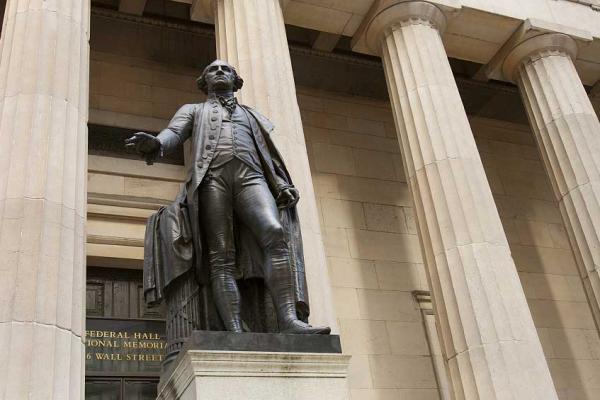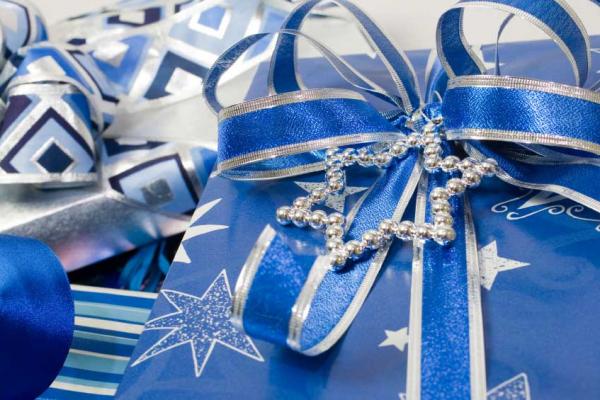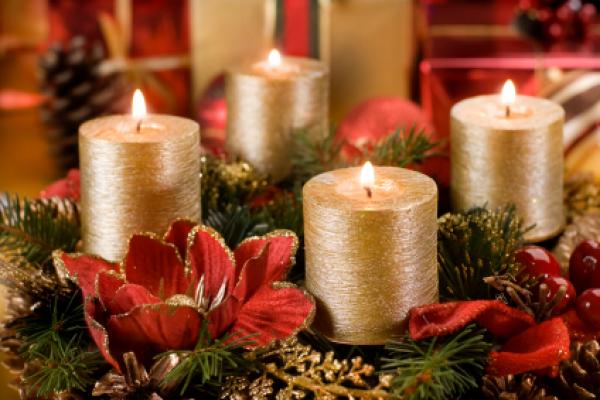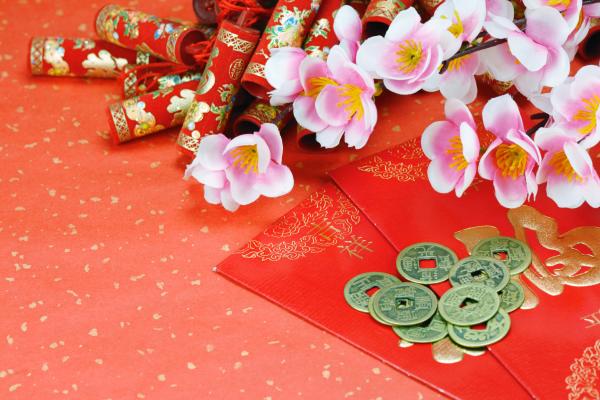Inauguration Day occurs in the USA once every four years on January 20. It occurs in the year after presidential elections have been held. The new terms of office of the president and vice-president officially begin at noon in Washington DC.
 George Washington was the first person to be inaugurated as president of the USA.
George Washington was the first person to be inaugurated as president of the USA.
©iStockphoto.com/Kohlerphoto
What do people do?
On Inauguration Day the candidates, who won the elections in the previous year, are sworn into office as president and vice-president of the United States. The swearing-in ceremony takes place at the U.S. Capitol and is organized by the Joint Congressional Committee on Inaugural Ceremonies. It is usually followed by a parade along Pennsylvania Avenue.
The new president watches the parade from the presidential viewing stand in front of the White House. The route of the parade is often lined by thousands of people. However, many Americans watch the ceremony on television or listen to it on the radio.
Public life
Inauguration Day is not a public holiday and many people are expected to work as usual. Many schools, stores and other organizations are open as normal in many parts of the USA. Public transport services run on their regular schedules. There may be changes to normal broadcasting schedules on television and radio, as news stations cover the inauguration ceremony.
Inauguration Day is a federal holiday for some federal employees who work in the District of Columbia or the surrounding areas. This is mainly to reduce the amount of congestion on the roads and public transit systems of the area.
In and around Washington DC there can be considerable disruption to public life, both on Inauguration Day and in the days before and after the ceremony. This is not only due to the actual ceremony and parades that accompany it, but also the protests and demonstrations that are organized and the massive security operation that takes place. If you have business affairs in this area in the second half of January in an inauguration year, it is wise to check carefully that you will be able to do what you need to.
Background
The head of state of the USA has been a president since 1789. In that year, George Washington was elected and inaugurated as president of the United States of America. He was inaugurated for the first time on April 30, 1789, and for the second time on March 4, 1793. Subsequent inaugurations were held on March 4 until the second inauguration of President Franklin Roosevelt on January 20, 1937. Since then Inauguration Day has been held on January 20 and the term of office officially starts at 12:00 noon on that date.
Usually the vice-president is sworn in first and the president at exactly 12:00 noon. After they have been sworn in, the president and vice-president are given four ruffles and flourishes. The ruffles are played on drums and the flourishes on bugles, which are simple brass instruments with no valves. The ruffles and flourishes form a fanfare before performance of the president’s anthem, “Hail to the Chief”, and the vice-president’s anthem, “Hail, Columbia”. There is then a 21-gun salute from the howitzers of the military district of Washington.
After the ceremony, the president and vice-president are guests of honor at a luncheon given by the United States Congress. Later in the day, they parade down Pennsylvania Avenue and walk part of the way from the Capitol to the White House. If Inauguration Day falls on is a Sunday, the presidential oath is usually administered in a private ceremony on that day and a public ceremony and celebrations are held on the following day.
On January 20, 2009, Barack Obama will be the first African American president to be inaugurated. The results from the USA election, which was held on November 4 in 2008, determined that Obama would be the next president to lead the nation.
Courtesy of TimeandDate.com
Many Jewish communities in the United States observe the first day of Hanukkah, which marks the start of Hanukkah, also known as Chanukah or Festival of Lights. Hanukkah is an eight-day Jewish observance that remembers the Jewish people’s struggle for religious freedom.
 Hanukkah gifts wrapped and ready to be given.
Hanukkah gifts wrapped and ready to be given.
©iStockphoto.com/MarkCoffeyPhoto
What do people do?
Jewish communities in the United States celebrate the first day of Hanukkah on the 25th day of the month of Kislev in the Jewish calendar. The Hanukkah period lasts for eight days and is celebrated from the 25th day of Kislev to the second day of Tevet. The first night of Hanukkah (or Chanukah) starts with special blessings at sunset the day before the 25th of Kislev. Many Jewish people light the hanukiah (or chanukkiyah), which is a type of candelabrum.
Many Americans of Jewish faith also eat food fried in olive oil, such as potato cakes, and different fried breads. Hanukkah dishes include sufganiot (Hanukkah donuts), potato latkes (pancakes), mandelbrot (this can be sliced like a hard bread), and rugelach (pastry that with different fillings). The first day of Hanukkah is the start of a celebratory period in which a four-sided toy called dreidel is used for games. The first night of Hanukkah is also a night when people sing traditional songs to celebrate Hanukkah. Gift-giving is also popular at this time of the year.
Public life
The first day of Hanukkah is not a federal public holiday in the United States. Some Jewish schools have their school vacation fall around the same time of Hanukkah.
Background
Hanukkah commemorates the Jewish people’s successful rebellion against the Greeks in the Maccabean War in 162 BCE. A ritual cleansing and re-dedication of the Temple occurred after the Jewish people’s victory. It is believed that there was only enough consecrated oil to keep the lamp burning for one day but the small bottle of oil miraculously lasted for eight days. Hanukkah, also known as Chanukah, is referred as the Feast of Lights or Festival of Lights for this reason.
Moreover, the survival of Judaism over the many years is also celebrated during this period. The last day of Hanukkah, which marks the end of Hanukkah, falls on the eighth day of this period.
Symbols
The dreidel is a toy that is popular during the Hanukkah celebrations. It is a spinning top with a different Hebrew letter inscribed in each of its four sides – the four letters form an acronym meaning “a great miracle happened here”. The hanukiah (or chanukkiyah) is a type of candelabrum that holds eight candles to commemorate the eight days that the oil burned and a ninth candle that sits apart, known as the shamash, or servant candle that lights the others. One candle is lit on the first night, another on the second, and so forth until all candles are lit on the last night.
About Chanukah/Hanukkah (first day) in other countries
Read more about Chanukah/Hanukkah (first day).
Chanukah/Hanukkah (first day) Observances
Note: Jewish holidays begin at sundown the day before the date specified for the holiday.
Courtesy of DateandTime.com
The Advent season marks the beginning of the Christian year across many western churches in the United States. Its length varies from 22 to 28 days, starting on the Sunday nearest St Andrew’s Day and encompassing the next three Sundays, ending on Christmas Day.
 Advent wreaths can be seem in some churches in the United States during the Advent season.
Advent wreaths can be seem in some churches in the United States during the Advent season.
©iStockphoto.com/Dušan Zidar
What do people do?
Many Christians in the United States attend a church service on the first Sunday of Advent and may engage in activities such as special prayers and contributing to ideas on enhancing peace. Many Advent traditions are observed in the United States in the prelude to Christmas Day. For example, the Advent wreath is becoming increasingly popular in the United States. The wreath can be seen in various churches across the nation around this time of the year.
Advent calendars of all designs are also given as gifts at this time of the year. The calendars feature openings in the form of windows or doors that are numbered to count the days to Christmas. Calendars may contain chocolates, toys, or candy and are given to children as a fun way to observe the Christmas countdown. Some traditional Advent calendars show 24 days but many Advent calendars showing 25 days, with the last opening on Christmas Day.
The church year begins in September 1 in many eastern Christian churches, so Advent begins at a different time to when it starts in the western churches. The eastern equivalent of Advent is called the Nativity Fast, which runs for 40 days.
Public life
The first Sunday of Advent is not a nationwide public holiday in the United States. However, churches may be busy on this day, as well as families who use the beginning of Advent as a time to prepare for the Christmas season.
Background
It is uncertain as to when exactly the celebration of Advent was first introduced in the Christian church. Some sources say that Advent began on November 11 (St Martin’s Day) at some time in the fifth century in the form of a six-week fast leading to Christmas. Advent was reduced to its current length at some stage in the sixth century and the fasting was later no longer observed. Advent is originally a time to reflect and prepare for Christmas similarly to how Lent is in preparation for Easter. Advent has sometimes been referred to as the Winter Lent. In recent times the restrictions that Advent brings to Christians have become more relaxed.
Advent traditions spread from Europe to the United States, especially the Advent calendar, which became very popular in the United States after World War II as American military personnel and their families who were stationed in Germany brought them home and made them a part of the pre-Christmas traditions. Some people credit President Dwight Eisenhower with helping the tradition of the Advent calendar spread in the United States during the 1950s.
Symbols
Purple is historically the main color used for Advent because it reflects penitence, fasting, and the color of royalty to welcome the Advent of the king (Jesus Christ). The focus of the entire season is the celebration of the birth of Jesus the Christ in his first Advent, and the anticipation of the return of Christ the King in his second Advent. Some churches use other colors in recent times. For example, some churches mark the third Sunday of Advent with pink or rose, colors that represent joy. Many Protestant churches use blue to distinguish the Season of Advent from Lent.
Advent wreaths are symbolic of Advent. They are usually made of fir and decorated with gold and silver ribbons or scarlet woolen threads. Lit wreaths may be displayed on the table where family and friends sit while singing carols and preparing handmade gifts.
About First Sunday of Advent in other countries
Read more about First Sunday of Advent.
Courtesy of DateandTime.com
Many people in countries such as the United States celebrate Chinese New Year, also known as the Spring Festival or the Lunar New Year. It marks the first day of the New Year in the Chinese calendar.
 Chinese New Year decorations, including red envelopes for money.
Chinese New Year decorations, including red envelopes for money.
©iStockphoto.com/Liang Zhang
What do people do?
Many individuals and communities, particularly Chinese communities, in the United States take part in the Chinese New Year celebrations, which can last for days. Chinese New Year celebrations in the United States have, over the years, included activities and events such as:
- Chinese New Year parades featuring colorful costumes, floats, firecrackers and other attractions.
- Various dances, including lion and dragon dances.
- Chinatown fun runs or walks.
- Balls and pageants.
- Street fairs.
- Firework displays.
Some organizations may hold special contests or make announcements to coincide with Chinese New Year. For example, some newspapers or magazines may announce the top 10 Chinese restaurants in a city or town on Chinese New Year. It is customary for many Chinese-American families to spend time together and exchange gifts, including money wrapped in red and gold packages that are usually given to children.
Public life
Chinese New Year is not a federal public holiday in the United States. However, some Chinese businesses may be closed on the day or amend their business hours to take part in the Chinese New Year festivities. There may be heavy traffic and some streets may be closed in towns or cities where Chinese New Year celebrations are held.
Background
According to the U.S. Census Bureau (Census 2000: Chinese Largest Asian Group in the United States; March 4, 2002), the Chinese comprised more than 20 percent of the 11.9 million people who identified themselves as Asians in the United States’ Census 2000. That translates into 2.7 million reporting as Chinese – the largest Asian group in the United States.
Chinese historical organizations in the United States can trace the arrival of the Chinese in North, Central and South America as far back as the 1600s. Many Chinese immigrants settled in the United States during the 19th century. With immigration, came Chinese traditions and events such as Chinese New Year, which is now largely celebrated in many communities across the United States.
Symbols
Chinese New Year has various symbols and traditions. For example, flowers are an important part of New Year decorations. Writings that refer to good luck are often seen in homes and business environments. They are usually written by brush on a diamond-shaped piece of red paper. Tangerines and oranges are also displayed in many homes and stores as a sign of luck and wealth.
Envelopes with money (Hong Bao, Ang Pao, or Lai See) often come in the color red, which symbolizes happiness, good luck, success and good fortune. These envelopes are mainly given as presents to children. Each Chinese New Year is associated with an animal name for one of 12 animals in the Chinese zodiac.
About Chinese New Year in other countries
Read more about Chinese New Year.
Courtesy of DateandTime.com
